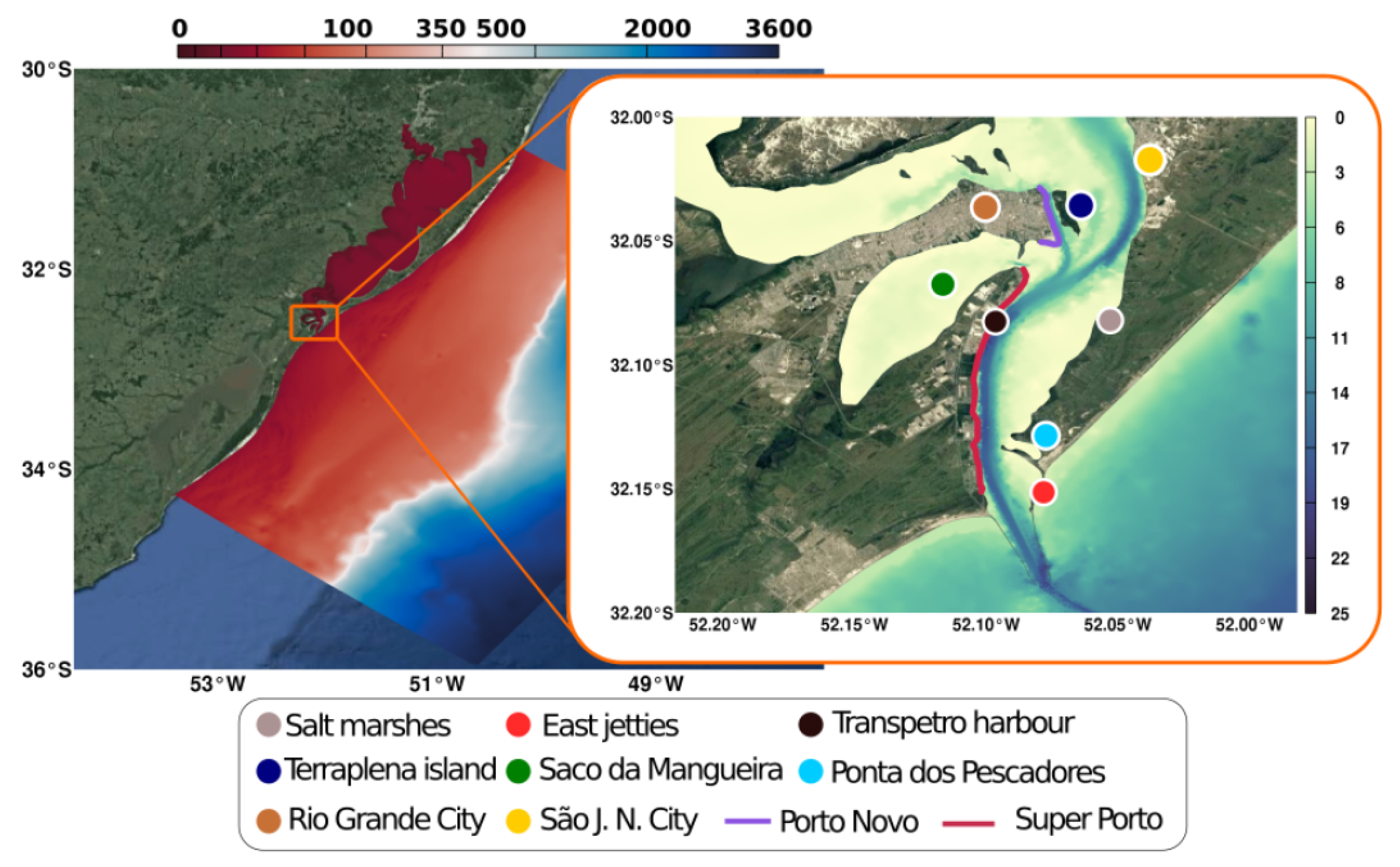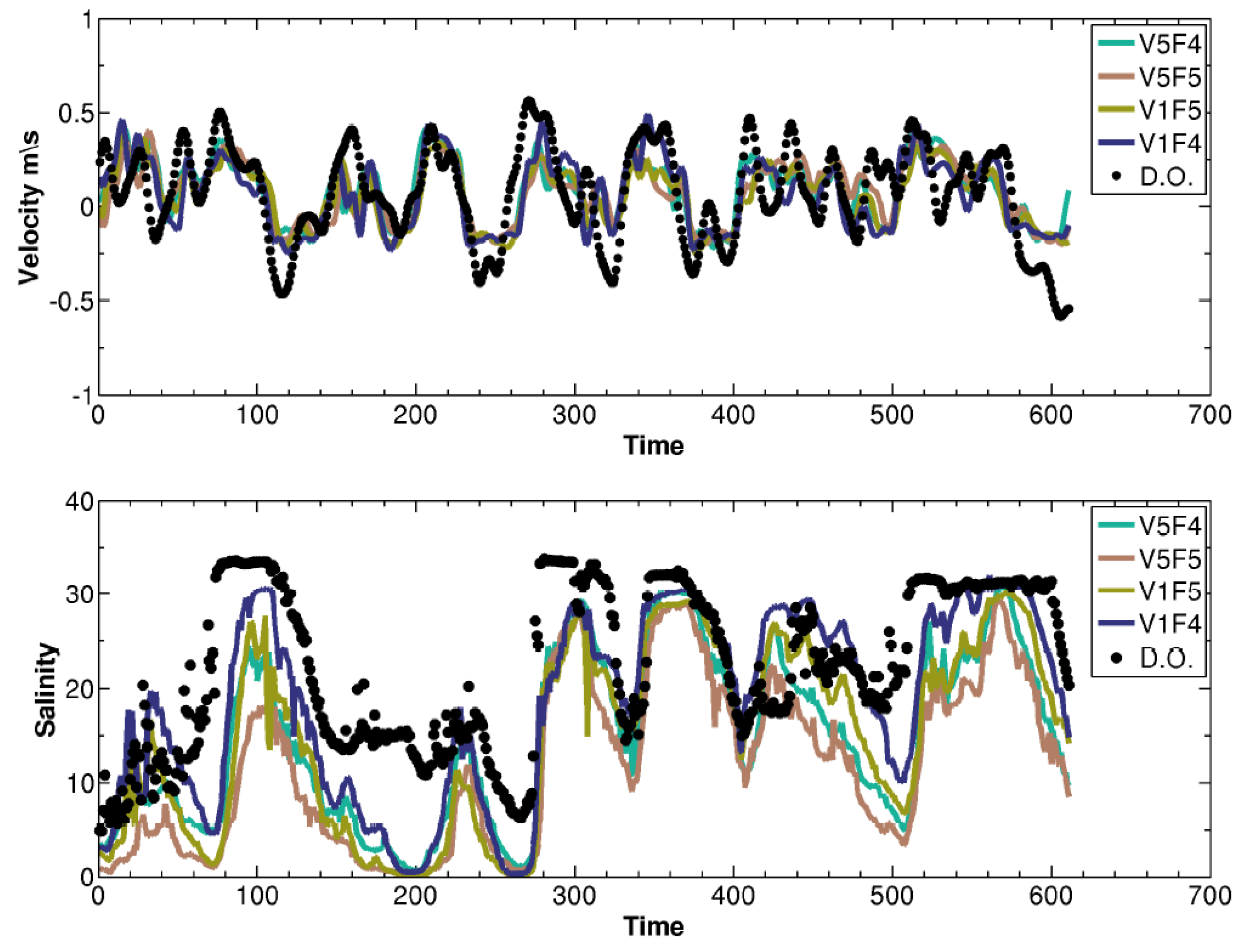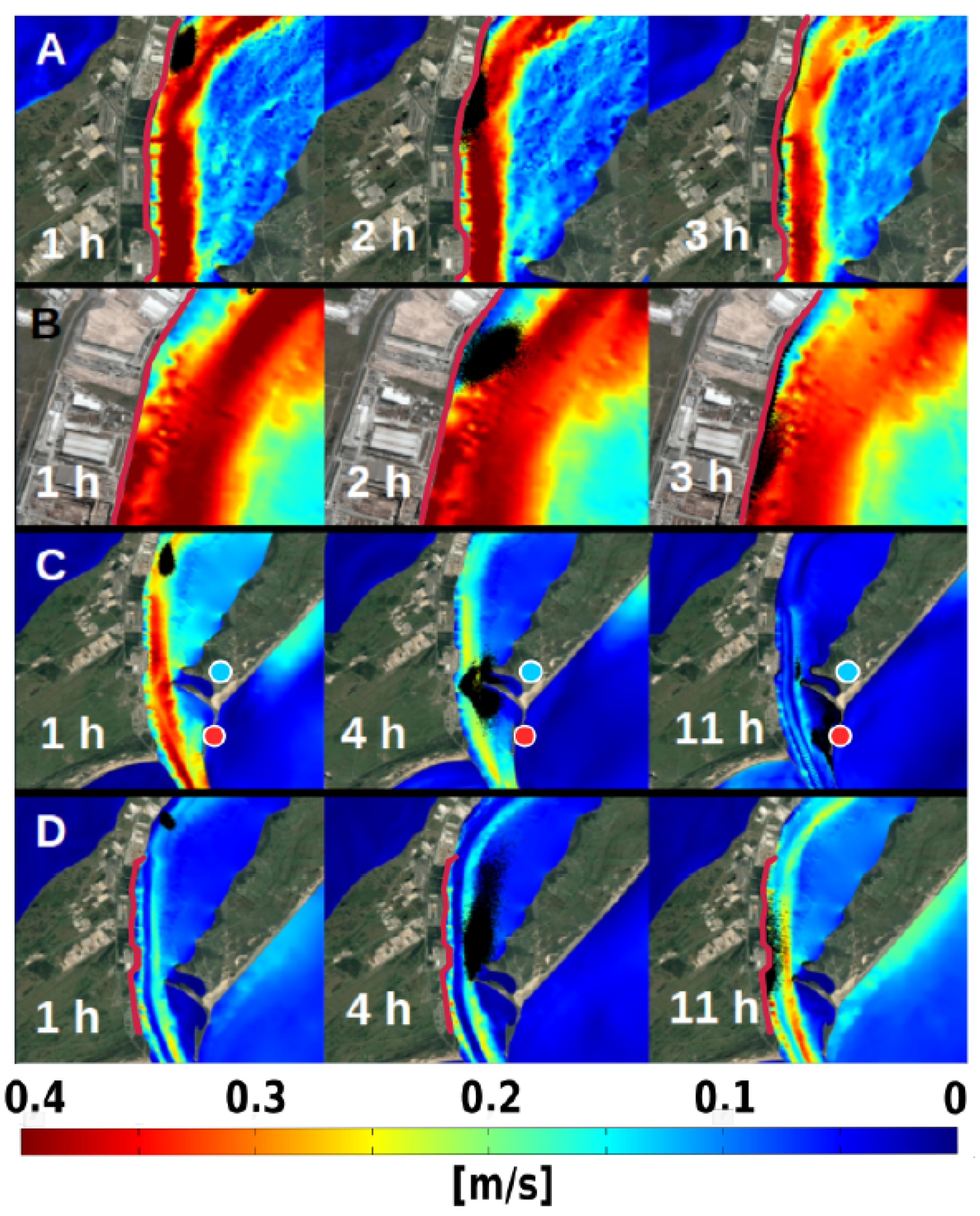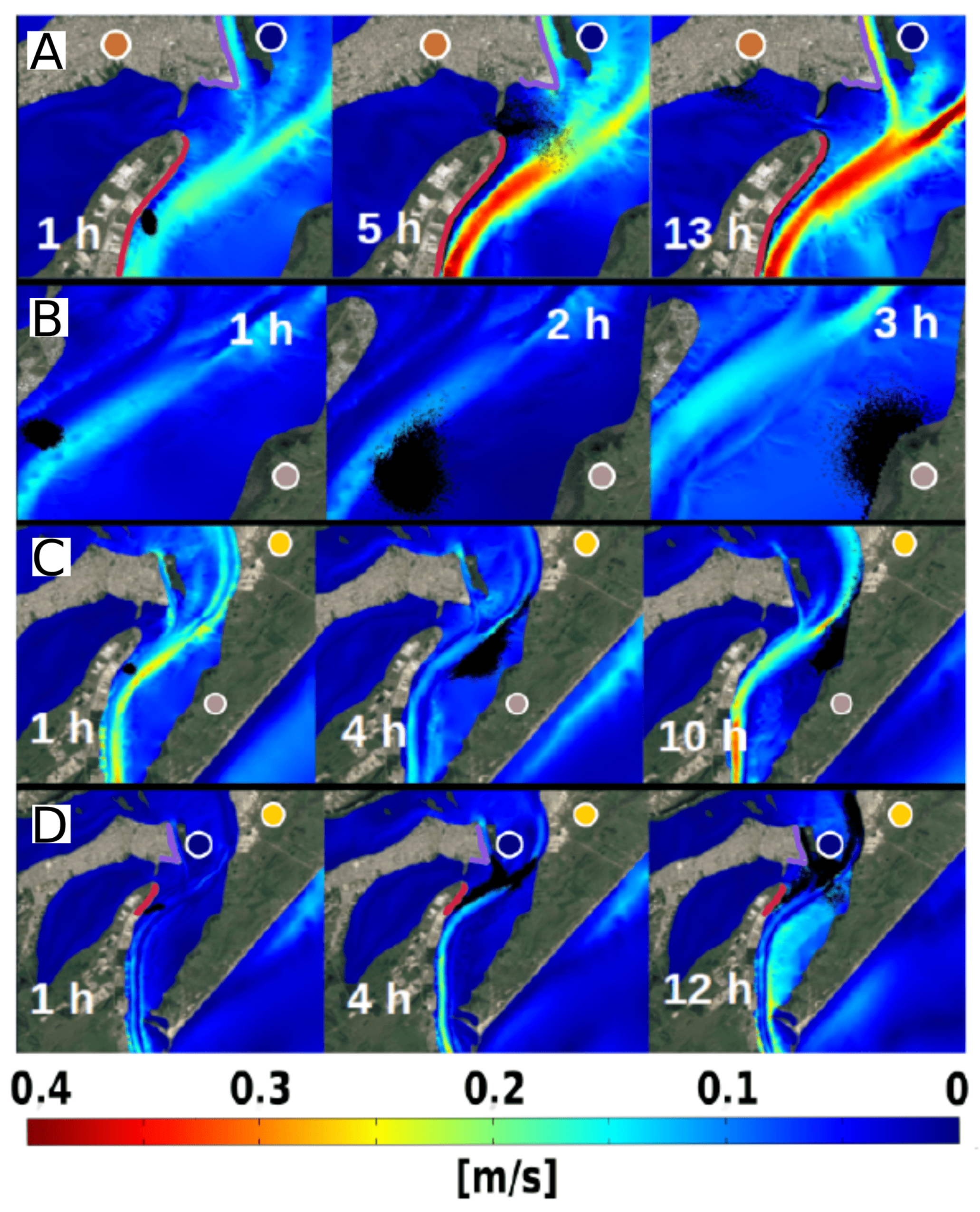Numerical Study of Oil Spill in the Patos Lagoon Under Flood and Ebb Conditions
Abstract
:1. Introduction
2. Methodology
2.1. Numerical Model
2.1.1. Advection
2.1.2. Scattering
2.1.3. Turbulent Diffusion
2.2. Initial and Boundary Conditions
2.3. Setup and Validation
3. Results
4. Conclusions
Author Contributions
Funding
Acknowledgments
Conflicts of Interest
References
- Gurjar, B.R.; Sharma, R.K.; Ghuge, S.P.; Wate, S.R.; Agrawal, R. Individual and Societal Risk Assessment for a Petroleum Oil Storage Terminal. J. Hazard. Toxic Radioact. Waste 2015, 19, 4015003. [Google Scholar] [CrossRef]
- Lopes, C.F.; Milanelli, J.C.C.; Poffo, I.R.F. Ambientes Costeiros Contaminados Por óleo: Procedimentos de Limpeza—Manual de Orientação; Secretaria de Estado do Meio Ambiente: São Paulo, Brazil, 2007; p. 120.
- Thomas, J.E. Fundamento de Engenharia de Petróleo. Editora Rio de Janeiro Interciência Petrobras, 2nd ed.; Jose Eduardo Thomas: Rio de Janeiro, Brazil, 2004; p. 267. [Google Scholar]
- Caruso, M.S.F.; Alaburda, J. Hidrocarbonetos policíclicos aromáticos-benzo(a)pireno: Uma revisão. Rev. Inst. Adolfo Lutz 2008, 67, 1–27. [Google Scholar]
- Clark, R.B. Marine Pollution; Oxford University Press: New York, NY, USA, 2001. [Google Scholar]
- Bollmann, M.; Bosch, T.; Colijn, F.; Ebinghaus, R.; Froese, R.; Güssow, K.; Khalilian, S.; Krastel, S.; Körtzinger, A.; Langenbuch, M.; et al. World Ocean Review—Living with the Oceans; Maribus GmbH: Hamburg, Germany, 2010; pp. 232–236. [Google Scholar]
- Stringari, C.E.; Correa Marques, W.; Eidt, R.T.; Mello, L.F. Modeling an Oil Spill along the Southern Brazilian Shelf: Forcing Characterization and Its Influence on the Oil Fate. Int. J. Geosci. 2013, 4, 397–407. [Google Scholar] [CrossRef]
- Boehm, P.D.; Murray, K.J.; Cook, L.L. Distribution and Attenuation of Polycyclic Aromatic Hydrocarbons in Gulf of Mexico Seawater from the Deepwater Horizon Oil Accident. Environ. Sci. Technol. 2016, 50, 584–592. [Google Scholar] [CrossRef]
- Liu, X.; Guo, M.; Wang, Y.; Yu, X.; Guo, J.; Tang, C.; Hu, X.; Wang, C.; Li, B. Assessing pollution-related effects of oil spills from ships in the Chinese Bohai Sea. Mar. Pollut. Bull. 2016, 110, 194–202. [Google Scholar] [CrossRef] [PubMed] [Green Version]
- Sebastião, P.; Soares, C.G. Modeling the Fate of Oil Spills at Sea. Spill Sci. Technol. Bull. 1995, 2, 121–131. [Google Scholar] [CrossRef]
- IBAMA. Informação Técnica ELPN/IBAMA N 023/02—Modelagem de Derramamento de Óleo no Mar; Ministerio do meio Ambiente: Rio de Janeiro, Brazil, 2002.
- Möller, O.O.; Casting, P.; Salomon, J.C.; Lazure, P. The influence of local and non-local forcing effects on the subtidal circulation of the Patos Lagoon. Estuaries 2001, 24, 275–289. [Google Scholar] [CrossRef]
- SUPRG. Superintendência do Porto de Rio Grande. Movimentação por Segmento de Carga ano 2016; SUPRG: Rio Grande, Brazil, 2017. [Google Scholar]
- Lynch, D.R.; Ip, J.T.C.; Naimie, C.E.; Werner, F.E. Comprehensive coastal circulation model with application to the Gulf of Maine. Cont. Shelf Res. 1996, 16, 875–906. [Google Scholar] [CrossRef]
- Hervouet, J.M. Hydrodynamics of Free Surface Flows: Modelling with the Finite Element Method; John Wiley & Sons: Hoboken, NJ, USA, 2007. [Google Scholar]
- Marques, W.C.; Stringari, C.E.; Kirinus, E.P.; Möller, O.O., Jr.; Toldo, E.E., Jr.; Andrade, M.M. Numerical modeling of the Tramandaí beach oil spill, Brazil—Case study for January 2012 event. Appl. Ocean Res. 2017, 65, 178–191. [Google Scholar] [CrossRef]
- Marques, W.C.; Stringari, C.E.; Mello, L.F. ECOS—Easy Coupling Oil System. Patente: Programa de Computador. Título: “ECOS—Easy Coupling Oil System”; Universidade Federal do Rio Grande—FURG: Rio Grande, Brazil, 2013. [Google Scholar]
- French-McCay, D. Oil spill impact modeling: Development and validation. Environ. Toxicol. Chem. 2004, 23, 2441–2456. [Google Scholar] [CrossRef]
- Fay, J.A. The spread of oil slicks on a calm sea. In Oil Sea; Springer: Boston, MA, USA, 1969; pp. 53–54. [Google Scholar]
- Proctor, R.; Elliot, A.J.; Fiather, R.A. Forecast and hindcast simulations of the Braer oil spill. Mar. Pollut. Bull. 1994, 28, 219–229. [Google Scholar] [CrossRef]
- Flores, H.; Andreatta, A.; Llona, G.; Saavedra, I. Measurements of oil spill spreading in a wave tank using digital image processing. Trans. Ecol. Environ. 1998, 27, 9. [Google Scholar] [CrossRef]
- Al-Rabeh, A.H.; Cekirge, H.M.; Water, N.G. A stochastic simulation model of oil spill fate and transport. Appl. Math. Model. 1989, 13, 322–329. [Google Scholar] [CrossRef]
- Sutherland, J.; Wallingford, H.R. Cosmos Modelling and the Development of Model Performance Statistics; TR121-EC MAST Project n° MAS3-CT97-0086; HR Wallingford Ltd.: Wallingford, UK, 2001; pp. 1–4. [Google Scholar]
- Oleinik, P.H.; Marques, W.C.; Kirinus, E.d.P. Estimate of the Wave Climate on the Most Energetic Locations of the South-Southeastern Brazilian Shelf. Defect Diffus. Forum 2017, 370, 130–140. [Google Scholar] [CrossRef]
- Simionato, C.G.; Meccia, V.L.; Dragani, W.C.; Nuñez, M.N. On the use of the NCEP/NCAR surface winds for modeling barotropic circulation in the Río de la Plata Estuary. Estuar. Coast. Shelf Sci. 2006, 70, 195–206. [Google Scholar] [CrossRef]
- Marques, W.C.; Fernandes, E.H.; Moller, O.O., Jr.; Moraes, B.C.; Malcherek, A. Dynamics of the Patos Lagoon coastal plume and its contribution to the deposition pattern of the southern Brazilian inner shelf. J. Geophys. Res. 2010. [Google Scholar] [CrossRef]
- Marques, W.C.; Fernandes, E.H.L.; Rocha, L.A.O. Straining and advection contributions to the mixing process in the Patos Lagoon estuary, Brazil. J. Geophys. Res. Oceans 2011, 116, 1–23. [Google Scholar] [CrossRef]
- Fernandes, E.H. Modelling the Hydrodynamics of the Patos Lagoon, Brazil. Ph.D. Thesis, University of Plymouth, Plymouth, UK, 2001. [Google Scholar]
- Fernandes, E.H.L.; Cecíclio, R.O.; Schiller, R.V. Estudo da influência da obra de convergência dos Molhes da Barra de Rio Grande sobre a circulação hidrodinâmica do Estuário da Lagoa dos Patos. VETOR- Revista de Ciências Exatas e Engenharias 2007, 15, 49–57. [Google Scholar]
- Soares, I.D.; Kourafalou, V.; Lee, T.N. Circulation on the western South Atlantic continental shelf: 1. Numerical process studies on buoyancy. J. Geophys. Res. Oceans 2007, 112. [Google Scholar] [CrossRef] [Green Version]
- Soares, I.D.; Kourafalou, V.; Lee, T.N. Circulation on the western South Atlantic continental shelf: 2. Spring and autumn realistic simulations. J. Geophys. Res. Oceans 2007, 112. [Google Scholar] [CrossRef] [Green Version]
- Costa, R.L.; Möller, O.O. Estudo da estrutura e da variabilidade das correntes na área da plataforma interna ao largo de Rio Grande (RS, Brasil), no sudoeste do Atlântico Sul, durante a primavera-verão de 2006–2007. Revista da Gestão Costeira Integrada 2011, 11, 273–281. [Google Scholar] [CrossRef]
- Mello, L.F.; Stringari, C.E.; Eidt, R.T.; Marques, W.C.; Costa, R.L.; Moller, O. Desenvolvimento De Modelo Lagrangeano De Transporte De Óleo: Estruturação e Acoplamento ao Modelo Hidrodinâmico TELEMAC3D. Pesquisas Aplicadas em Modelagem Matemática 2012, 1, 1–21. [Google Scholar]
- Moller, O.O.; Lorenzzentti, J.A.; Stech, J.; Math, M.M. The Patos Lagoon summertime circulation and dynamics. Cont. Shelf Res. 1996, 16, 335–351. [Google Scholar] [CrossRef]
- Marques, W. Padrões de Variabilidade Temporal nas Forçantes da Circulação e Seus Efeitos na Dinâmica da Lagoa dos Patos, Rio Grande do Sul, Brasil. Ph.D. Thesis, Universidade Federal do Rio Grande, Rio Grande do Sul, Brazil, 2005. [Google Scholar]
- Monteiro, I.O.; Pearsom, M.; Möller, O.O.; Fernandes, E.H.L. Hidrodinâmica do Saco da Mangueira: mecanismos que controlam as trocas com o estuário da Lagoa dos Patos. Atlântica (Rio Grande) 2006, 27, 8–101. [Google Scholar]
- Nogueira, R.X.d.S.; Costa, C.S.B. Sigmar: Aplicação e análise de sensibilidade das marismas a derrames de óleo. In XI Simpósio Brasileiro de Sensoriamento Remoto; FURG: Belo Horizonte, Minas Gerais, Brazil, 2003; pp. 1617–1619. [Google Scholar]
| 1 | |
| 2 | |
| 3 | |
| 4 |




| Simulation | Wind Friction Coefficient | Bottom Friction Coefficient |
|---|---|---|
| V1F4 | ||
| V1F5 | ||
| V5F4 | ||
| V5F5 |
| Parameters | V1F4 | V1F5 | V5F4 | V5F5 | |
|---|---|---|---|---|---|
| Current Velocity | Mean | 0.066 | 0.059 | 0.082 | 0.080 |
| Absolute Error | 0.155 | 0.161 | 0.158 | 0.159 | |
| Mean Square Error | 0.193 | 0.195 | 0.194 | 0.196 | |
| Coefficient Correlation | 0.661 | 0.648 | 0.652 | 0.645 | |
| Bias | −0.008 | −0.014 | 0.008 | 0.007 | |
| Salinity | Mean | 18.450 | 14.949 | 14.754 | 11.856 |
| Absolute Error | 5.740 | 8.019 | 7.976 | 10.622 | |
| Mean Square Error | 7.466 | 9.864 | 9.525 | 12.109 | |
| Coefficient Correlation | 0.768 | 0.750 | 0.780 | 0.757 | |
| Bias | −3.907 | −7.408 | −7.603 | −10.501 |
© 2019 by the authors. Licensee MDPI, Basel, Switzerland. This article is an open access article distributed under the terms and conditions of the Creative Commons Attribution (CC BY) license (http://creativecommons.org/licenses/by/4.0/).
Share and Cite
Vasconcellos Lopes, B.; Pavlovic, A.; Beloti Trombetta, T.; Oleinik, P.H.; Barbosa Monteiro, C.; Cardoso Guimarães, R.; Vieira da Silva, D.; Correa Marques, W. Numerical Study of Oil Spill in the Patos Lagoon Under Flood and Ebb Conditions. J. Mar. Sci. Eng. 2019, 7, 4. https://doi.org/10.3390/jmse7010004
Vasconcellos Lopes B, Pavlovic A, Beloti Trombetta T, Oleinik PH, Barbosa Monteiro C, Cardoso Guimarães R, Vieira da Silva D, Correa Marques W. Numerical Study of Oil Spill in the Patos Lagoon Under Flood and Ebb Conditions. Journal of Marine Science and Engineering. 2019; 7(1):4. https://doi.org/10.3390/jmse7010004
Chicago/Turabian StyleVasconcellos Lopes, Bruno, Ana Pavlovic, Thaísa Beloti Trombetta, Phelype Haron Oleinik, Caroline Barbosa Monteiro, Ricardo Cardoso Guimarães, Douglas Vieira da Silva, and Wiliam Correa Marques. 2019. "Numerical Study of Oil Spill in the Patos Lagoon Under Flood and Ebb Conditions" Journal of Marine Science and Engineering 7, no. 1: 4. https://doi.org/10.3390/jmse7010004
APA StyleVasconcellos Lopes, B., Pavlovic, A., Beloti Trombetta, T., Oleinik, P. H., Barbosa Monteiro, C., Cardoso Guimarães, R., Vieira da Silva, D., & Correa Marques, W. (2019). Numerical Study of Oil Spill in the Patos Lagoon Under Flood and Ebb Conditions. Journal of Marine Science and Engineering, 7(1), 4. https://doi.org/10.3390/jmse7010004






